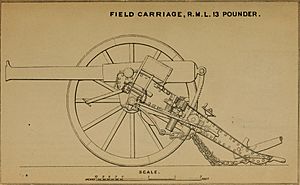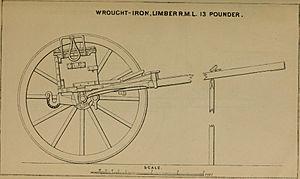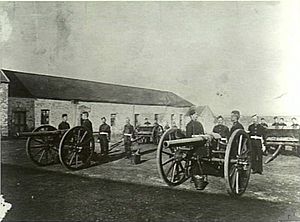RML 13-pounder 8 cwt facts for kids
Quick facts for kids RML 13-pounder 8 cwt gun |
|
|---|---|

RML 13-pounder 8 cwt Field Gun diagram, 1882
|
|
| Type | Field gun |
| Place of origin | United Kingdom |
| Service history | |
| In service | 1879–1902 |
| Used by | British Empire |
| Production history | |
| Designer | Woolwich Arsenal |
| Manufacturer | Woolwich Arsenal |
| Produced | 1879- |
| Variants | 13 pdr 8 cwt Mark I and II (Land Service) only |
| Specifications | |
| Mass | 8-long-hundredweight (400 kg) |
| Length | 7 ft 3 ins |
| Crew | 9 |
|
|
|
| Shell weight | 13 pounds (5.9 kg) (common shell) 13 pounds (5.9 kg) (shrapnel) |
| Calibre | 3 inches |
| Action | RML |
| Breech | none – muzzle-loading |
| Carriage | Horse drawn |
| Rate of fire | One round per minute |
| Muzzle velocity | 1,330 feet per second (405 m/s) |
| Effective firing range | 3,500 yards (3,200 m) |
| Sights | Centre sighted |
The RML 13-pounder 8 cwt gun was a powerful cannon used by the British army in the 1800s. It was a type of field artillery, which means it was designed to be moved around on battlefields. This gun was called "RML" because it was a Rifled, Muzzle Loading gun. This means it had special grooves inside its barrel (rifling) to make the shell spin, and you loaded the shell from the front (muzzle). The "13-pounder" part tells you the weight of the shell it fired, which was about 13 pounds (around 5.9 kg). The "8 cwt" refers to the gun's own weight, which was about 8 hundredweight (around 406 kg).
Contents
How Was the Gun Designed and Made?
The 13-pounder was the last type of "Rifled Muzzle Loading" field gun ever made. Production started in 1879. Unlike some older guns, the 13-pounder had a much longer barrel.
The gun's barrel was built in two main parts. An inner tube of strong steel was covered by an outer tube of tough iron. This made the gun very sturdy. Inside the barrel, there were 10 special grooves. These grooves made the shell spin as it left the gun, which helped it fly straight and hit its target accurately.
The gun also had sights placed in the middle of the barrel. These sights helped the gunners aim, whether they were shooting directly at a target or over a hill (indirect fire). There was also a flat spot on top of the barrel where a special tool called a clinometer could be used. This tool helped make sure the gun was level or could be used for another way of aiming indirectly.
How Did the 13-Pounder Gun Work?
These powerful guns were usually used in groups called "batteries." A battery would have either six or four guns working together. Each gun was very heavy, so it needed a team of six horses to pull it.
The gun had a crew of nine people. Five crew members could ride on seats attached to the gun and its front cart (called a limber). Three other people were drivers for the horses, and one person was the gun commander.
Besides the gun itself, a separate cart filled with ammunition was also pulled by horses. When used as "Field Artillery," these guns were designed to move at the same speed as soldiers walking. When used as "Horse Artillery," they were meant for situations where faster movement was needed.
To fire the gun, a silk bag filled with black powder was loaded into the muzzle. The gun used three main types of ammunition:
- Common shell: Used for attacking buildings or strong defenses.
- Shrapnel shell: Used against groups of soldiers or cavalry (soldiers on horseback).
- Case shot: Used for very close-range attacks against targets that weren't heavily protected.
To make the gun fire, a small copper tube was put into a hole at the back of the barrel. A rope (lanyard) was attached to this tube. When the gunner pulled the lanyard, the tube would ignite, causing the powder in the silk bag to explode and fire the gun. Different types of fuses could be used with the shells. Some fuses made the shell explode after a certain amount of time or distance, while others made it explode when it hit something. A skilled crew could fire about one shot per minute.
Where Was the 13-Pounder Used?
The 13-pounder gun saw action in the Anglo-Egyptian War in 1882. During this war, four batteries of these guns were used. Two batteries were with the Royal Horse Artillery, and two were with the Field Artillery.
The gun remained a main weapon for the Royal Artillery until the late 1880s. It was then replaced by a newer type of gun called the 15-pounder Breech-Loading gun.
Some 13-pounders were later given to volunteer artillery groups starting in 1889. They continued to be used until about 1902, when even more modern guns took their place. In 1896, for example, three of these guns were held by the South Australian Volunteer Artillery.
Where Can You See Surviving Examples?
You can still see some of these historical guns today!
- One example, complete with its carriage, is on display at Fort Rodd Hill in British Columbia, Canada.
- Another example in Canada is located inside the museum of the 5th (BC) Regiment, Royal Canadian Artillery.
- Two more surviving examples are on the parade ground at the Armed Forces of Malta's Headquarters barracks. These two guns were restored in 2005 by air defense personnel, with help from the Royal Artillery museum. They had been stored away for over a decade before being brought back to their former glory.
See also



